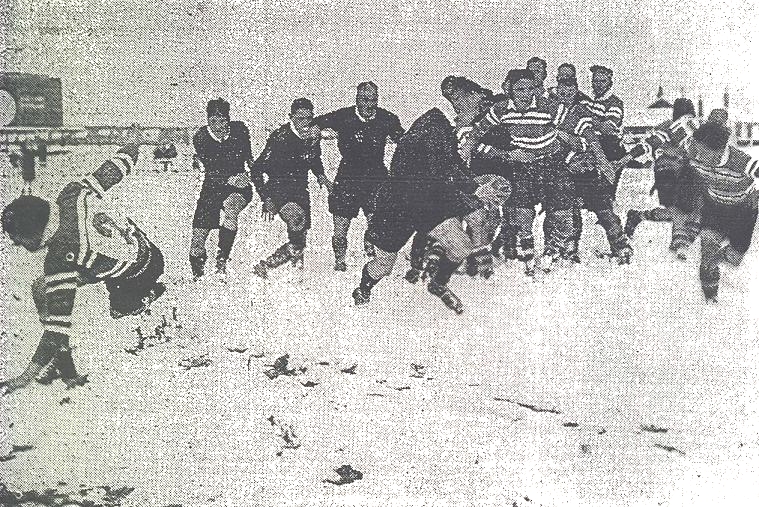
Ranfurly Shield Rugby in the Snow. Source: The Weekly News, August 1939
Among the benefits of giving public talks on the weather are the stories you get back from the audience. Once, after a lecture in Dunedin when I described the cyclone of 1936 as the worst storm to have hit New Zealand in the last century, a number of people mentioned the snow storm of 1939. I had never heard of it, but when I looked up the old newspapers, I was amazed to find that it affected pretty much the whole country.
On 31 July 1939, snow was reported by the lighthouse keeper at Cape Maria van Diemen at the top of the North Island. A few days earlier, it snowed in Dargaville and Ruapekapeka, and snow lasted on the hills behind Kaikohe for several hours. In Auckland, snow fell in many suburbs just before dawn on 27 July. Five cm of snow lay on the summit of Mt Eden, while the Bombay hills shone white for most of the morning.
In Gisborne, snow fell for nearly three hours, covering lawns and gardens. Snow fell to sea level at Castlepoint, too, and the road to Masterton was closed by drifts at Big Saddle on the Whakataki hill. Snow lay 15 cm deep in Masterton, where the town clock was stopped at 2.20am by the weight of snow on its hands.
In the east of the South Island, the falls were heavier. Snow cut off Banks Peninsula from Christchurch for a time, and lay 30 cm deep in Akaroa. Sixty men in a public works camp near Duvauchelle were without food for two days until a launch arrived with supplies. Stock sheltering in gullies were buried in snow drifts up to 10 m deep, and many perished. In places, snow covered the tops of fences, and sheep and cattle roamed at will. Although snow in Christchurch was only a few centimetres deep, a layer of frost on top caused numerous accidents and disrupted the tram service.
In Dunedin, conditions were much worse. Here snow and thunderstorms began during the evening rush hour on Monday, 24 July, and by morning snow lay 15 cm deep over the city. Only one bus made it out to the north over Mount Cargill, assisted by a gang of men with shovels. Electric trams did not commence running until the middle of the morning, and then only on certain lines on the flat.
Buses made some progress over the snow, but cars needed chains, and visibility was hampered for many whose windscreen wipers had frozen to the windscreens. The road to the south was closed, as was the airport. Some trains got through, running silently over the snow-covered rails.
The snow continued through Tuesday, and by Wednesday morning it was 35 cm deep at St Kilda and up to a metre deep in the more elevated suburbs of Roslyn and Maori Hill. Icicles 30 cm long were reported on some houses, and the weight of snow caused roofs and skylights to cave in. The only fatality occurred when a man clearing snow from a factory skylight fell 10 m to the floor.
The radio masts at Highcliffs, on Otago Peninsula, were struck by lightning, and the staff there isolated without adequate food. A rescue mission was launched under the command of the director of 4YA, H. Ninnis, who had been with Shackleton in the Antarctic. He was accompanied by four members of the Otago Ski Club. To transport the supplies they borrowed one of Captain Scott's sleds from the Otago Museum. When they reached the station, one of the men coming out to receive the supplies sank up to his neck in snow.
Supplies were also running short in many parts of town, as no fresh meat, vegetables, milk or coal were coming into the city.
However, the abundant snow provided a rare opportunity for people to enjoy winter sports. Snowballing was rife, with battles between rival groups of businesses downtown. Any moving target was fair game, including cars and buses, some of which lost windows, and the police were obliged to intervene. Snowmen sprang up all over town, and one school even managed to stage a paper chase, using Condy's crystals to stain the snow red and make a trail.
Skiers had a grand time eagerly assisting in rescue missions, including one farmer whose barn had collapsed. Tobogganing was also popular, with strips of linoleum and tea-trays called into service. Speeds of up to 70 km/h were reported and there were inevitable accidents. One concussion victim had to be carried by stretcher-bearers over 200 m of soft snow to reach the ambulance.
Inland, the train from Lumsden to Kingston was marooned at Eyre Creek when the engine charged into a drift and became stuck. Passengers and crew were forced to spend the night on the train, and had to raid the cargo for dinner.
Snow was not the only problem during the cold snap. Overnight frosts caused water pipes to burst in Palmerston North and Hastings, while at Paremata, just north of Wellington, eight hectares of the harbour froze over. Tidal waters also froze at Opotiki in the Bay of Plenty, where sheets of ice were left attached to wharf piles as the tide went out.
The cold continued for a while and Invercargill was covered in 15 cm of snow overnight from Friday to Saturday 12 August. The Ranfurly Shield game between Southland and Manawatu took place with only the lines cleared. Perhaps more used to the chilly conditions, Southland beat the North Islanders 17-3.
Up and down the country, it was regarded as the worst winter for snow in living memory. Considering how temperatures have warmed in the last seventy years, we may not see these conditions again.